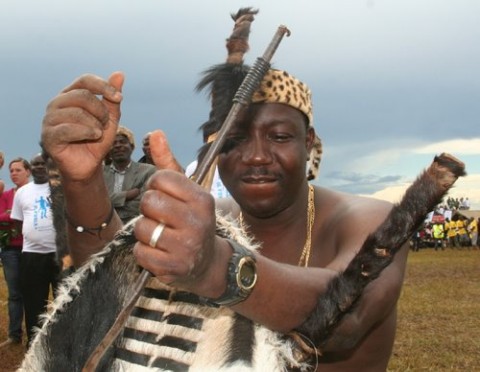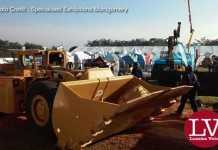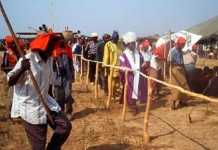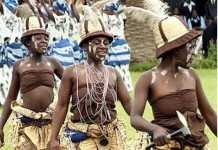IT is that time of the year again! The catchword in Chipata of the Eastern Province is Nc’wala ceremony of the Ngoni speaking people which reaches its climax today at Mtenguleni village.
All roads -tarmac, gravel and footpaths would lead to Kampala Village of Mtenguleni area, situated about, 35 kilometres away from the border town of Chipata.
Every last Saturday of February, the Ngoni people of Zambia who trace their origins from Kwazulu Natal in the rainbow country , South Africa trek to Mtenguleni main arena in Chipata to pay homage to Paramount Chief Mpezeni IV better known as Nkhosi Ya Makhosi, Ndabazithe, Thuto.
The annual Nc’wala traditional ceremony which is a ritual of thanks-giving to the Almighty God for the green harvest also commemorates the many victories of the Ngoni people.
The Ngoni people of Zambia migrated from South Africa as they feared the strong fist of the ancient war hero -Shaka Zulu.
On their way in search of arable land, they engaged in fierce battles with the many tribes they found.
It was for this reason that during the ceremony, all Ngoni chiefs wear warlike regalia. Clad in animal skin and clutching spears and knobkerries, the fearless Ngoni warriors or Impis show off their war prowess through the famous Ingoma dance.
The Ngoni Impis stomp the ground with bare feet while the women clap their hands while exposing their bare chests.
The beating of the hands creates an indigenous African rhythm beat that is said to evoke the spirits of the ancient Ngoni warriors.
A book written by Nwankwo Nwaezeigwe titled The Heritage Library of African Peoples explains that around 1817, the Mthethwa alliance,
which included the Zulu clan, came into conflict with the Ndwandwe alliance.
One of the military commanders of the Ndwandwe army was Zwangendaba kahlatshwayo who reigned from 1780-1848 as the head of the Jere or
Gumbi clan, which itself formed part of the larger emancwangeni alliance in what is now north-east KwaZulu-Natal.
In 1819 the Ndwandwe alliance was defeated by the Shaka, popularly known as Shaka Zulu at a battle on the Umhlatuze River near Nkandla.
Many of the Ndwandwes fled, and over a period of about 20 years Zwangendaba led a small group of his followers north through Zimbabwe
to the region around the Viphya plateau, between what is now called Lundazi district in Zambia and Mzimba and Karonga districts in Malawi and Matema district in Tanzania.
In this region the Ngonis established a state using Zulu warfare techniques of conquering and integrating with local peoples.
While the Ngoni have largely retained a distinct identity in the post-colonial states in which they live, integration and acculturation
has led to them adopting local languages. In present time, Zulu is used only for a few ritual praise poems.
Following Zwangendaba’s death in 1848, succession disputes split the Ngoni people further into five groups, some of whom moved to new territories.
Chief Madzimawe who is regarded as Gogo meaning a grandfather said Ngonis who settled in the Eastern Province of Zambia came from Durban in the Natal province.
He explains that from the Republic of South Africa, the Ngonis entered the country from Zimbabwe where Mzilikazi and his people the Ndebele remained.
The Ngoni are said to have crossed the Zambezi River near Zumbo where they experienced the eclipse of the sun in 1835 which up to date has remained a historical significant event to all the Ngonis.
Chief Madzimawe said further explains that the other group of the Ngoni warriors who wore animal skins usually leopard skins to be precise, wielding spears, club and shields passed through Mozambique and entered Zambia through Petauke district.
They went through the Luangwa valley and entered the Bisa-Lala land. The Ngoni reached Tanzania where Zwangendaba died near Lake Tanganyika (Songeya).
The sons scattered, Mtaiven went to Kenya, Zulu-Gama remained in Tanzania, M’Mbelwa went to Malawi and Mpezeni went and conquered the
Bemba land.
It was further that the Bemba people gave Paramount Chief Mpezeni a wife in whom Chief Mwamba was born creating the birth of an ancient
cousinship between the people of Eastern Province and the Bembas which was cherished to date.
It is believed that later on, Paramount Chief Mpezeni (Nsingo) moved up to Chipata where he exhibited his warriors skills when he fought bravely against the whites.
British colonial government soldiers who were led to him by a fellow Ngoni warrior only known as Chapalapata killed Nsingo.
Due to the expansion of the Ngoni kingdom in Zambia by conquering other tribes, the British colonial government had no option but to ban all Ngoni traditional ceremonies in the country until in 1980 when the ceremony was revived again.
This ritual that had broken prominence was revived in 1980 from its 70 years of slumber.
British rulers who had feared active political resistance from the fierce Ngoni warriors almost managed to consign it to obscurity. It is believed that the British colonial government did not understand the characteristic Ngoni stomping of feet and brandishing of their clubs which accompanied all songs sung at ceremonies.
At present one would be correct to say the ceremony is surely claiming back its position among the top cultural traditional ceremonies this country can proudly boast to attract more tourists.
Paramount Chief Mpezeni would be celebrating the 32nd reign as a traditional leader.
Today, there are a total of 11 Ngoni chiefs in Zambia under Paramount Chief Ngwenyama Inkhosi yamakosi Mpezeni IV who has settled in
Luangeni at his Imphudukeni palace in Chipata, few metres from the Zambia-Malawi Mwami border.
The warriors have always been associated with cattle and they have always kept kraals known as Chibaya among them, a symbol of prestige.
All the Ngoni chiefs command Kraals and all the installations of Ngoni chiefs take place in a Kraal.
Each chief has to come from a Kraal and any Ngoni chief should be identified or associated with a kraal from where he hails no wonder
all the Ngoni chiefs in Zambia have traditional kraal names given to their palaces.
Senior Chief Nzamane comes from the Mfumbeni Kraal. Chief Madzimawe who is usually in Ngoni traditional gear regarded as Gogo Mazimaweâ meaning grandfather comes from the Mtenguleni kraal, which happens to be the venue of the Nc’wala ceremony.
Chief Mishoro is from the Dingeni kraal. Others are Chief Mnukwa who comes from the Chikenkhe kraal and Chief Kapatamoyo hails from
Thondweni kraal while Chief Maguya is from the Ngiyelo kraal.
The rest of the Ngoni chiefs include Chiefs Saili from Chiphinga kraal, Chief Mshawa of the Khutchweni kraal and Chief Chinyaku from
the Ndina kraal.
In Malawi, a total of eight Ngoni Chiefs reign under Paramount Chief Inkosi yama Khosi Mberwa. These include senior chiefs Mzikuola,
Maulawo, Mzukuzuku and Mtwalo while others are Chief Mphelembe, Chindi Mulonyeni and Zulu.
The ancient Nc’wala traditional ceremony signifies the union of the Ngoni people of eastern Zambia and part of Malawi and Tanzania as they prove their unique cultural identity and image as a warring tribe that conquered and defeated many tribes as they searched for better lands.
The ceremony is a rare occasion when the Ngoni tribesmen rejoice and dance freely with their paramount chief in the arena.
Even other tribes available in Zambia take advantage to participate in dancing the Ingoma which was free for all who attends.
Nc’wala forms part of the rich cultural diversity this country had been blessed with as it comes first on the calendar year on the last
Saturday of the month of February each year.
Three days before Nc’wala (Wednesday) all impis gather at Mtenguleni village to welcome invited guest. The following day paramount Chief Mpezeni shits from his Emphendukeni palace to Kampala village where he is kept in a seclusion place called Laweni.
On the eve of the ceremony, the number of Impis grows as with the number of guests as and tourists with entertainment continues until
dawn.
The ceremony reaches crescendo today when the guest honour pays a courtesy call on Paramount Chief Mpezeni at Laweni before taking their seats in the main arena.
The paramount chief then emerges from Laweni dormitory clad in a leopard and lion skins brandishing a shield and a spear amid
ululations and Zulu language praise.
Before the paramount chief embarks on a 10-minute walk to the main arena with his impis a small ritual of king’s praises is performed just outside the Laweni dormitory.
The Great East Road is closed for an hour to facilitate the movement of the Ngonis from Laweni to Mtenguleni.
The moment Chief Mpezeni entres the main arena, all present rise to a standing ovation until the entourage takes its place Paramount Chief on the throne and all the Ngoni chiefs at his feet.
The climax of the ceremony comes when a black bull is slaughtered by the Ngoni impis in the main using a spear.

 JOIN DRIVERN TAXI AS PARTNER DRIVER TODAY!
JOIN DRIVERN TAXI AS PARTNER DRIVER TODAY!












What’s Going down i am new to this, I stumbled upon this I
have discovered It absolutely helpful and it has helped me out
loads. I am hoping to contribute & help different users like its helped me.
Great job.